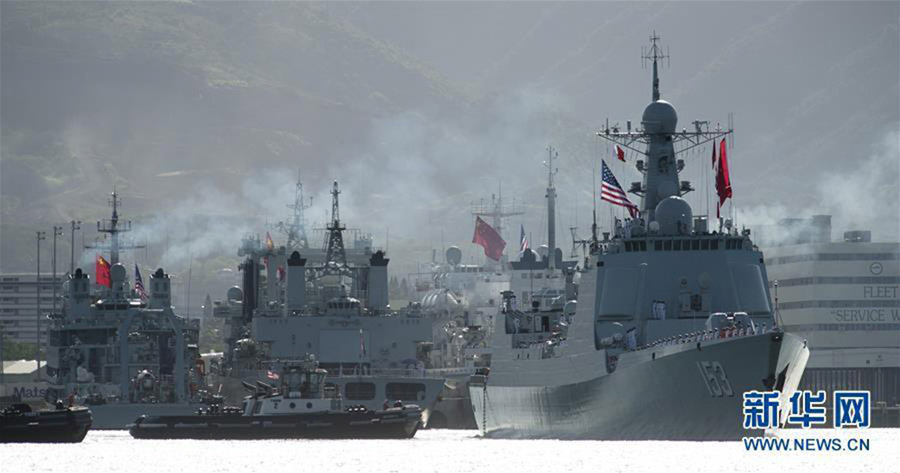


File Photo: A PLA Navy ship participating in the Rim of the Pacific (RIMPAC) exercise leaves Pearl Harbor, July 12, 2016
The U.S. is going to great lengths not to talk in terms of containment, but its behavior speaks a different language. Recently, U.S. Secretary of Defense Ash Carter announced a third phase of the rebalance to the Asia-Pacific. In the new phase, the U.S. will continue to sharpen its “military edge” in order to remain “the most powerful military in the region and the security partner of choice,” he says. He also says that the rebalance is not an effort to contain or isolate anyone, without mentioning China by name. The Chinese are not fooled.
The U.S. Government views developments in the Asia-Pacific as linked to the long-term economic and security interests of the U.S. According to the Department of Defense FY 2017 budget fact sheet, the U.S. is preparing to take measures to preserve and enhance deterrence, including targeted investments in emerging capabilities; provide $425 million for the Southeast Asia Maritime Security Initiative over five years; enhance U.S. military presence in the region; continue to fly, sail, and operate in the South China Sea; and ensure readiness on the Korean peninsula. The goal is to “project power…and win decisively against any adversary” when and if necessary, according to the fact sheet.
Fortunately, this aggressive posture in the Asia-Pacific is not endorsed by all members of the government and military in the U.S. The White House is taking a more cautious approach. According to a recent article published in Navy Times, the current administration has effectively banned the term “great power competition” in official discourse, used by both Defense Secretary Carter and Chief of Naval Operations Admiral John Richardson to describe the challenge of China, because it oversimplifies the complex relationship and places the two sides on a course of conflict. The White House and the Pentagon are split on how to deal with China’s growing power and influence in the region.
The U.S. has already seriously affected the security situation in the Asia-Pacific with the current approach. In the first phase of the pivot strategy, a large number of U.S. military personnel were shifted to the Asia-Pacific; in the second phase, advanced capabilities were introduced. Now, the U.S. seeks to “qualitatively upgrade and invest in” its regional force posture, according to the Secretary of Defense. This will help the U.S. achieve its goal of ensuring that the U.S. military remains “the world’s finest fighting force,” but doubling down on the rebalance effort will also raise regional tensions and increase the likelihood of serious conflict. A different solution is needed.
At the recently concluded 7th Xiangshan Forum in Beijing, an international platform for defense officials and security experts, various solutions were put forward on the South China Sea topic. For example, China’s Defense Minister Chang Wanquan says it is urgent for all of us to abandon old strategies and instead work together to establish a security network that is based on common interests. Wu Shicun, President of the National Institute for South China Sea Studies in Hainan, says that China and the U.S. should establish a conflict and crisis prevention mechanism. People on both sides of the Pacific are looking for a solution to avoid future conflict.
A new-type of collective security mechanism that bridges all sides rather than divides is needed. The U.S. concept of a “principled and inclusive security network” sounds appealing, but it favors the U.S. position. Recent advice by the commander of the U.S. Pacific Command underscores this point. Admiral Harry Harris Jr., who openly calls China “provocative and expansionist,” says maintaining a network of like-minded allies and partners is a core element of the strategic approach to the security environment, even though Carter says that the security network is not a formal alliance. Old thinking in U.S. foreign policy should go the way of the dodo.
The present situation in the Asia-Pacific is relatively calm, but that can change quickly. A possible third phase that seeks to guarantee U.S. military superiority in the region will make the two countries become even more suspicious of each other, and thus damage bilateral ties. President Barack Obama and Secretary of State John Kerry both have said that the U.S. welcomes the peaceful rise of China, but the rebalance effort sends a different signal. The U.S. should be consistent and coherent and convince China of its benign intentions through its actions.

 Who Will Fit The Chinese Roles In Game Of Thrones?
Who Will Fit The Chinese Roles In Game Of Thrones? China's Hubei Shennongjia added to World Heritage List
China's Hubei Shennongjia added to World Heritage List Cute Dog At Fruit Stand Becomes Latest Internet Sensation
Cute Dog At Fruit Stand Becomes Latest Internet Sensation Top 10 livable Chinese cities
Top 10 livable Chinese cities The last primitive tribe in China
The last primitive tribe in China China's first intelligent security robot debuts in Chongqing
China's first intelligent security robot debuts in Chongqing A Total of 3,552 Subscribers Vanish In Two Days; YouTube Closes All Doors to Users’ Inquiries
A Total of 3,552 Subscribers Vanish In Two Days; YouTube Closes All Doors to Users’ Inquiries Out of this world! Futuristic UFO-shaped yacht has its own garden and a stunning underwater viewing deck
Out of this world! Futuristic UFO-shaped yacht has its own garden and a stunning underwater viewing deck An old tea house in Chengdu
An old tea house in Chengdu Furious Customer Crushes All the Buns from Vendor Just Because He Was Given the Wrong Flavor
Furious Customer Crushes All the Buns from Vendor Just Because He Was Given the Wrong Flavor